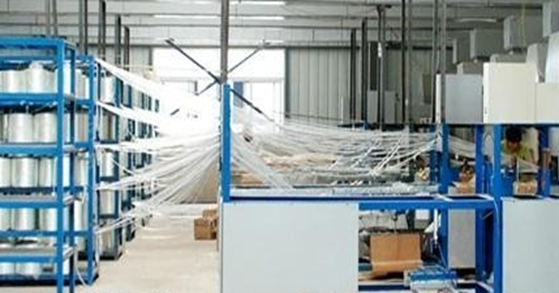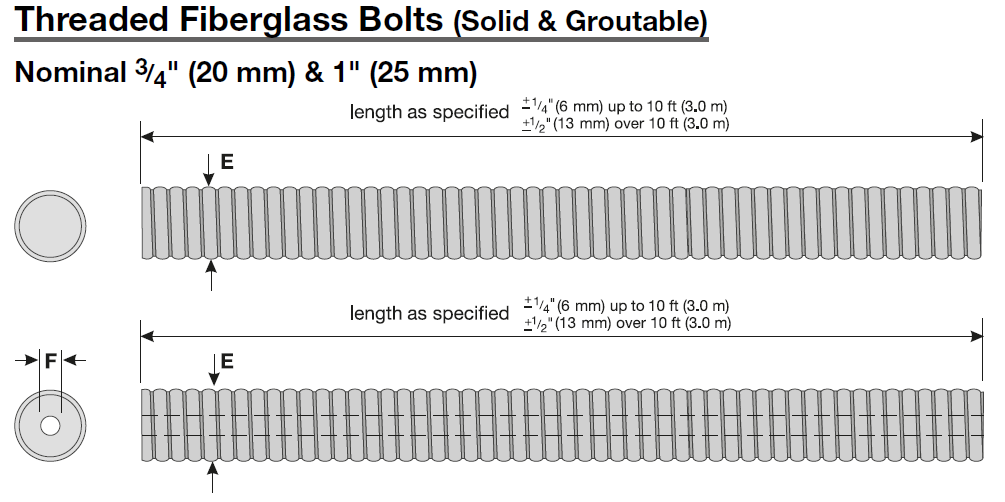FIBRE GLASS
Types of Bolts 0 CommentFibre Glass (FG) Dowels / Fibre – Reinforced Polymer (FRP)
FG and FRP dowels are made by pultrusion, a process that combines extrusion and pulling of molten or curable resin and continuous fibres usually arranged in unidirectional layers, through a die of a desired structural shape (“pull” and “extrusion”). FG dowels are made of glass strands pulled through a saturated thermo set resin and heated (See opposite). Presently FG dowels used in coal mines rib support have continuous rope thread profiles providing deformations for high bond strength with resin and rock. Other factors contributing to the increased application of polymeric dowels, as elements of support instead of steel, include:
- Improvement in the strength properties of the non-steel based dowels. The ultimate tensile strength of presently made 22 mm diameter dowels can range between 57 – 85 % of steel rebar of the same diameter.
- Easy and safe handle-ability of the non-steel dowels particularly FG and FRP, as both polymeric dowels are non-hazardous and will not cause splintering or any other side effects,
- Lightweight, fire resistant and easy to handle,
- Both plastic and FG dowels are relatively cheap,
- Cuttable, longer lasting and can be supplied a greater length.
FG dowel presently marketed in Australia is characterised as having lower yield deformation against shearing, and can twist on torqueing. Properties and characteristics of polymeric bolts are variable depending on the chemistry of the product, dowel diameter, solid or hollow core, surface profile shape and composition. Dowels of the same core diameter can vary in length, identified by dowel colour and colour coding. Typical dowel lengths with colour coding include dowel length 1.2 m (blue), 1.5m (orange), 1.8m (red) and 2.1 m (green). However, there has been a growing interest in black coloured dowels. Procedures used for evaluating strength integrity of dowels are based on Australian and various international standards. These include American Standards of Testing Materials (ASTM. C-759, 1991), The British Standard (BS 7861- Parts 1 and 2, 1996), International Standard ISO 10406-1 (2008), South African Standard, SANS1534 (2004) and others. In general, many well-known standards are invariably interrelated; however, the suitability of any particular standard, for testing of the given property of the dowel, will depend on the purpose of the dowel use and host medium properties.
Strength Properties of Dowel
The tensile and shear strength of dowels are the common tests carried on dowels. The tensile strength od the dowel is determined by a simple pull testing method (see opposite). A 1.3 m length of the dowel has its ends embedded in 450 mm steel tube. The bonding of the dowel in steel tube is carried out using either resin grout or expansive cement grout.The internal lining of embedded tubes was threaded with 2 mm threads and in accordance with recognised test standards such as ISO-10 406-1:200. The elongation of the 110 mm length of the middle section was monitored using an accurate extensometer as shown in Figure opposite.
The current reporting of the shear strength of dowels is normally based on guillotine testing of the FG rod in steel apparatus. Guillotining of the GRP dowels in steel shear apparatus yields lower shear values and is an unrealistic test. Other methods of evaluating the shear strength of dowel include; It is important that the shear strength of dowels must be determined based on simulated ground conditions, and therefore testing dowels in rock or concrete. Accordingly there is a need for establishing a credible testing methodology and procedures of marketed dowels. The double shear testing of dowels in concrete blocks represents a novel approach to simulating the shear behaviour of dowel in rock formation in situ. Figure opposite shows a double shearing methods of testing dowels in concrete. The load displacement profiles are also shown. Naturally the shear behaviour of dowel will depend on the strength of the concrete used for testing and dowel’s pretension loads and grout type.






